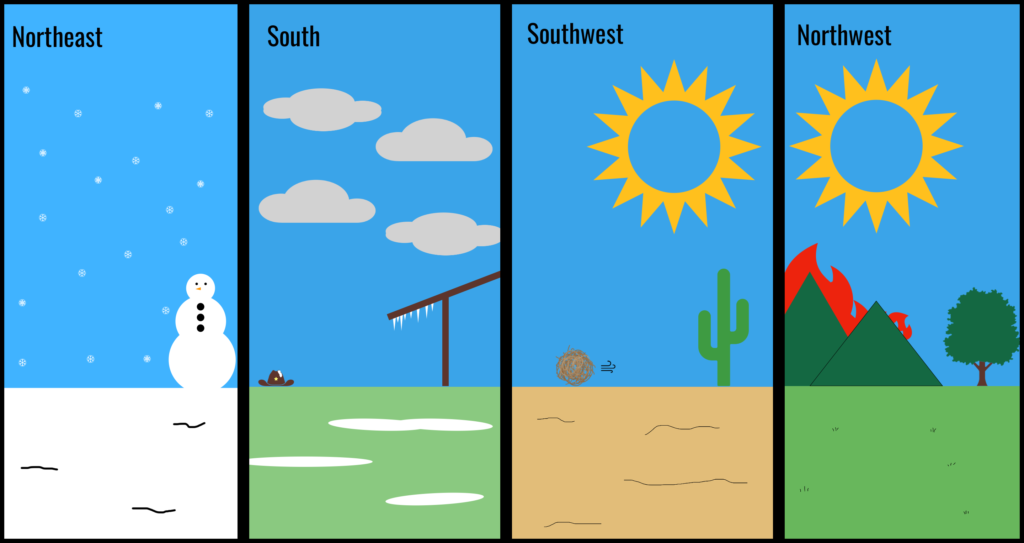Across the U.S., underground utilities occupy space at different depths. Many factors influence the depth you may find these pipes, cables, and wires, such as the local landscape, population density, and importantly, the regional climate. Due to regional climate variations within the U.S., these modern roots must be protected from fires, water damage, freezing, and extreme heat depending on regional factors. Underground utilities have much more protection from extreme weather events than above ground facilities like transmission lines and telephone poles, and local weather plays a huge role in determining the appropriate depth when utilities are placed below the surface.

While no region is a simple as a single weather pattern, utilities must be resilient to the highest highs and lowest lows the region can offer as well as particular regional considerations.
Beginning with the Northeastern United States, one main hazard that the weather poses to underground utilities is the ground freezing during winter. Gas and water lines can be damaged when the ground freezes by the continuous expansion of ice from both inside and outside the pipes.
In the worst cases, this can cause pipes to rupture. Pipes in New England must be buried at a minimum of six feet underground to prevent freezing damage in colder climates. Contrast that to the Southern United States, where the 2021 winter storm that hit Texas resulted in freezing that severely impeded delivery of natural gas. Gas lines in Texas are usually buried one and a half to two feet below ground because Texans have not historically had to worry about freezing impacting gas lines. For the sake of resilience, deeper placement of utilities can further insulate from temperature swings – whether hot or cold – and can help minimize damage from excavation too.
In the Northwest, recent heat waves, drought, and fires have affected utilities immensely. Some utility companies have even started to move electrical lines underground to avoid fires and other issues. Once underground, however, other opportunities for damages to occur, such as excavation damage by unknowing digging projects. Still a cold region, the northwest also must protect its utilities from the concerns of freezing, even while heat and fire incentivize further undergrounding. Washington state’s 12-inch minimum below the local frost depth has largely prevented freezing-related damages to utilities in the state and across the Pacific Northwest.
In the Southwest, more intense heat waves and longer droughts can put a strain on agricultural operations, which could lead to continual strain on water utilities in the region. Similar to the Pacific Northwest, an increase in different types of wildfires can also result in utilities choosing to move their lines underground. The state of Arizona has a 12-inch minimum for residential gas lines that may need to change, as winter storms have the potential to impact Arizona’s gas systems.
Whether above or below ground, the service lines powering and sustaining modern life face a number of risks. Weather, temperatures, accidents, and even animals can lead to leaks, spills, and service interruptions. Taking these service lines underground can insulate the facilities from most issues, but raises the risk of damage from digging projects where excavators cannot see what is below. That is why thinking of the utilities and service lines powering homes and buildings as modern roots can help prevent damage – you know there are roots underfoot wherever there are trees, so when buildings and infrastructure are present, digging should be done cautiously.
Modern Roots vary widely across the U.S., and regional climates are a critical factor in determining the depths you may find these roots. Different regional standards for utility depths mean that calling 811 is even more important if an excavator has recently moved to a different part of the country. You shouldn’t rely on believing a line is at a certain depth when determining to dig. This is especially important because depths can shift and change overtime, due to natural movement and maintenance work.
No matter the depth of a utility, following best practices is essential. But knowing the depth can be handy for avoiding damage. Call 811 before every digging project – and whether you are in a freezing region or fire-prone area, know that there is likely underground infrastructure beneath your feet at multiple levels.
Learn more about Aii’s #ModernRootsMarch by visiting its webpage here.
Written by Roy Mathews, Public Policy Associate
The Alliance for Innovation and Infrastructure (Aii) is an independent, national research and educational organization. An innovative think tank, Aii explores the intersection of economics, law, and public policy in the areas of climate, damage prevention, energy, infrastructure, innovation, technology, and transportation.